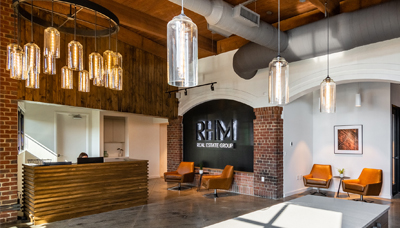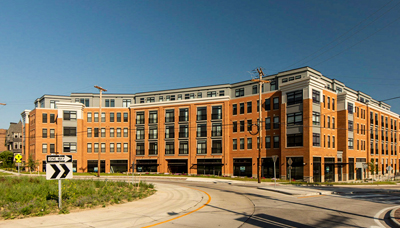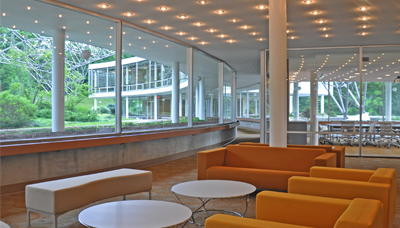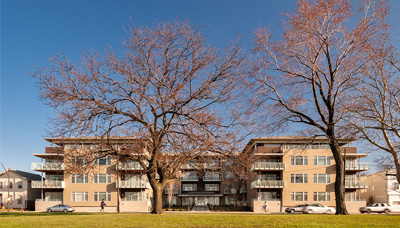Originally published in Properties Magazine, April 2022. Story by Dan Holland
The Lofts at The East End are the latest development phase in the former headquarters of the Goodyear Tire and Rubber Company at 1140 E. Market St. in Akron. The East End is a 1.4-miilion square foot mixed-use “live/work/play” campus that offers apartment living, athletic facilities, entertainment venues, restaurants, retail shops, Class A office space and more in a modern urban village setting.
Initial redevelopment of the Goodyear buildings began in 2012 when Industrial Realty Group LLC (IRG) and affiliated management group IRG Realty Advisors LLC, of Richfield, worked with the City of Akron and Goodyear to aid the company in relocating to a new 639,000-square-foot global headquarters along with a 3,500-car parking deck and two Innovation Centers located a short distance south of The East End on Innovation Way.
The Hilton Garden Inn Akron – an early addition to the East End campus — opened in late 2014 (see Properties, January 2015). In addition, a $4 million quarter-mile-long streetscape beautification project was completed in 2016.
The Residences at The East End, which offers 106 apartments within the top four floors of the former 320,000-square-foot Goodyear Hall at 1201 E. Market St., opened in 2015. The building, which sits directly across the street from the former headquarters, houses the Goodyear Theatre, Goodyear Hall Gymnasium, office space and a number of retail shops and restaurants (see Properties, November 2015).
Originally known as Goodyear Plant 1, the renovated former headquarters now houses a number of tenants, including Babcock & Wilcox, SummaCare, Ernst & Young, Akron Preparatory School and others. The common areas and office tenant spaces were developed during the first two development phases.
Amenities available to residents and tenants include a café bar and lounge area, cafeteria/restaurant, conference rooms, community room, convenience store, fitness club, golf simulator and an outdoor courtyard seating area. The main lobby was designed to resemble that of an upscale hotel.
The Lofts at The East End, which began welcoming residents in November 2021, has already reached 30 units leased. The $20 million project, which makes up phase three of the redevelopment plan for the 1.1 million square-foot building, consists of 66 upscale loft-style apartments located in the top three floors, covering 97,000 square feet. The complex features a 45-space indoor resident parking garage in the lower level that includes a pet wash room. A secured outdoor parking area at the rear of the 40-acre complex is planned for the future.
“This project exemplifies what we as a company do,” explains Michele Kiernan, project executive for IRG Realty Advisors. “We took a former Goodyear headquarters building and tried to keep all of it intact while repurposing for multiple different uses. The fact that we were able to keep that building standing while being able to relocate Goodyear and keep them within the city of Akron and the state of Ohio is such a win for all of us.”
Phase three begins
Pride One Construction, located in Medina, was construction manager for The Lofts. Work began in September 2020 and was completed in October 2021.
“At the time we came in, I think drawings were pretty well done by then, but they didn’t have the whole project put together yet,” explains Tom Harmon, project manager for Pride One. “We became involved in the project early on when they had just begun demoing that section of the building when we started the bidding process and any value engineering options or what challenges we were going to have on the project. Simultaneously, as they demoed their way out, we moved right in behind them to start building the apartments.”
Lakewood-based Dimit Architects LLC was chosen as the architectural design team.
Maintaining historical integrity
The Lofts received a total of $15.8 million in state and federal historic tax credits, according to Diana Wellman of Naylor Wellman LLC, of Chagrin Falls, who was the historic preservationist consultant on the project.
“They wanted to renovate these 66 apartments, which was an Ohio tax credit project, and we had to abide by all the requirements to maintain the tax credits,” says Gary Ogrocki, principal at Dimit. “It’s a unique building, with trying to preserve as much of that character as we could but still changing its use from an office to apartments.
Requirements for historic tax credit purposes varied for different portions of the project, depending on whether a section of the project related back to the original 1917 building or a 1971 revitalization, explains Brent Redeker, project executive for IRG Realty Advisors.
“That’s why we kept the metal cladding for this building, and were able to do that working with the state historic and federal historic commissions,” says Redeker. “They gave latitude whether we would showcase what would be considered more of an office look, because in 1971, there was a huge amount of office space in that building. But there were also areas of the building that were unused and reflected back to the original 1917 construction. From an interior perspective, we had an opportunity to go back and forth a little bit with approval looking at more of an industrial look or a modern office look.”
Exteriors
The building exterior along East Market Street features a metal panel facade that was attached to the original brick face in 1971. The interior courtyards and rear of the complex reveal the original red brick facing.
Exterior windows had to replicate the original appearance in order to satisfy historic tax credit requirements. Balconies added to select units along the inner courtyard and upper alley also had to abide by the requirements.
“As far as the historic reviews, they still look at the elevations off River Street on the back side,” explains Redeker. “That did steer what the entrance looked like, because they wanted a few changes made as well. It also drove the number of balconies on the building and keeping them out of primary sightlines. The historic tax credits are definitely a key part of their review in trying to keep the original sightlines and window lines as we went through and either replaced or refurbished windows.”
Interior Layout
A new lower-level (second floor) lobby is located down a ramp that wraps around the building toward the indoor parking garage entrance and delivery bays in back. The lobby features floor-to-ceiling windows, ceramic tile flooring and area carpets, custom-made wood furnishings and upholstered seating options. A wall mural of downtown Akron and a variety of paintings created by local artists, along with iron sculptures designed by Dimit, decorate the space.
“The art program was expanded with the apartments,” explains Rex Carpenter, director of architecture, planning and design for IRG Realty Advisors. “We brought in a consulting firm that found local artists in the respective galleries that IRG owns, whose work is represented throughout the building. That was something that we wanted to do from early on in that building. It’s a multi-phase project that we can see developing in the rest of the building; there is art proposed for each phase.”
The lobby and Interior corridors feature exposed white, wood beam ceilings while gray LVT flooring, made to resemble concrete, lines the corridor floors. Both features were necessary for maintaining historic tax credits. An adjacent mail room, package room, restrooms and two sets of elevators are located just off the lobby.
A cage-style storage locker room, available to residents, is also located on the lobby level.
Loft apartments
The apartments are located on floors five, six and seven and feature 56 one-bedroom and 10 two-bedroom units with a variety of layouts ranging in size from 637 to 1,700 square feet. Select units come with wrought-iron balconies that face the inner courtyard. All units are equipped with stainless steel kitchen appliances and an island with a painted faux white brick base to invoke the loft warehouse feel. Storage cabinets and electrical outlets are situated below the island countertops. Each unit features an individual heat pump, water heater and a stackable washer/dryer unit.
Many apartments feature original exposed brick and block walls along with steel structural elements that reflect the industrial history of the building. A variety of decorative, opaque window panels or shelf openings are situated between the bedrooms and kitchen/living areas to bring light into interior spaces. Bathrooms feature ceramic tile floors, a floating vanity and glass door shower stall.
“Some of the finishes were driven by the tax credits or the historical requirements,” explains Katie Hopper, interior designer for Dimit. “With some elements – such as the vertical glass in the kitchen division – we were finding ways to allow that natural light in but also maintain privacy for the bedrooms.”
Eight-foot-high entry doors give a vertical sense of the space in tandem with the exposed ceilings. Unit ceiling heights vary from 12-feet, six-inches on floors five and six, and up to 16 feet on the seventh floor. All units feature LVT flooring and ceiling fans. Operable, insulated windows feature manual shades. A different color palette, unique to accents on each floor level, is also reflected inside the units themselves.
Building systems
The original building structure consists of poured concrete columns, wood-packed floors and reinforced steel enclosed with a brick exterior. The roof features flat-plank wood decking with reinforced steel covered by an EPDM roofing membrane system.
A series of boilers in the building’s central plant and an existing cooling tower tie into a heat pump loop for the units.
Challenges
As with any historic renovation project, a number of challenges had to be met with creative solutions. For instance, attaching new custom-made balconies to a select number of units posed some logistical challenges as there was no access to position lift equipment within the inner courtyard, explains Harmon.
“The balconies were a major challenge on this project; attaching those to the building,” he says. “We ran into multiple challenges, as there was steel at the door opens where we didn’t think there was steel. We had to spend a lot of time to overcome that – mounting them through the three wythe of brick and adding structure inside the building to support them, then replacing any of the existing build that was disturbed. We had to make the new elements so that they still all fit in with the industrial look the design team put together that I think really suits the building. Its structural needs were a little different than a typical building due to the wood-packed floor and exterior wall construction.”
Spaces for various conduits servicing the apartments had to be fashioned. “We had to create spaces between each unit to run all of the mechanicals up through, as far as HVAC ducts, water loops, water lines, drain lines and such,” Harmon explains. “We had to create spaces to run everything through and then cut through the wood-packed floor to install shafts while trying to miss structural items as well, to make sure we weren’t trying to go through a steel beam on the lower floors.”
The top portion of an original mechanical tower that extended through the full height of the building was converted into apartment spaces on the upper floors, explains Redeker.
“On the ground floor, there were doors to access the mechanical space,” he explains. “On the upper floors, there were exhaust and fresh air intake grills and we were able to swap those out for windows. From a design standpoint, a great feature is turning what was unused space into some of the nicest apartments in the entire project.”
Future phases
With tens of thousands of square feet still available for redevelopment in the building, additional future residential projects will be forthcoming.
“I can’t speak to how many [units], because it’s driven by the market and how we use the space,” says Kiernan. “But It’s logical that we would move forward with the next phase of apartments. That’s part of what we’re working on now, but it’s too early to say how many and what they will look like.”
Building transformation
“I really enjoyed the process even from the very beginning, just seeing the building evolve,” says Harmon. “We’ve done quite a few historic renovations. Working on a building and bringing it back to life is rewarding. I still think back to walking through that seventh floor where the kitchen and cafeteria were located. To walk through there now, it’s hard to believe we were able to transform that seventh-floor space into apartments. With the teamwork that was in place, we really enjoyed working with IRG and Dimit and look forward to working with them again on future projects.”
A unique destination
“The East End Lofts brings a unique offering where the historic past meets today’s up-and-coming revitalization trend,” says Paul Harris, general manager of The East End for IRG Realty Advisors. “When paired with the amenities like our fitness center, golf simulator, café, bar, and a wide-open and well-laid out lobby, those features set us apart from our competition, while also being conveniently close to major travel arteries and downtown Akron.”
“The East End couples all of these amenities with walking distance mixed-use assets – such as the Hilton Garden Inn, Starbuck’s, Handel’s Ice Cream, Pita Pit, Marques, Eighty-Three Brewing, Goodyear Theater, Rubber City Sports, Residences at The East End and Goodyear Hall — to fulfill a true version of the live-work-play-and-stay commitment to our town. We are great neighbors, and we’re committed to growing and welcoming more residents and business partners each and every year.”




